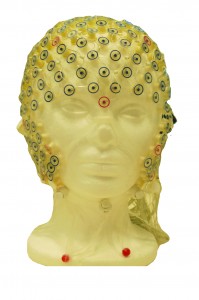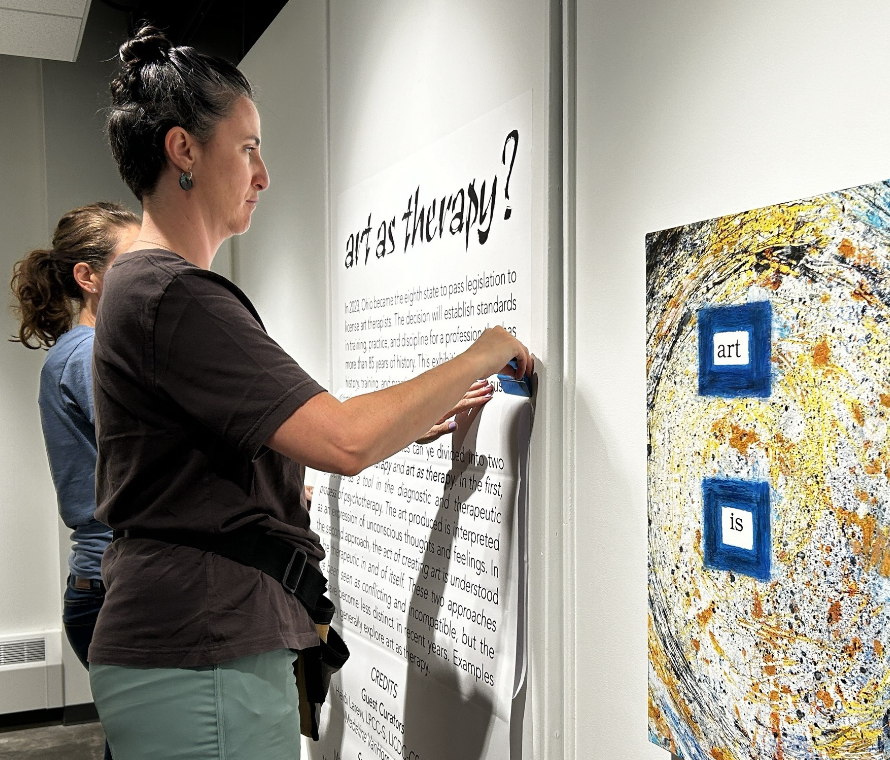Written by: Pamela Kellman
Where traditional methods of marketing research are subjective, The University of Akron is merging two fields and many different disciplines to give a more objective understanding of consumer behavior: neuroscience and marketing.
Dr. Christine Crish, research manager at the Suarez Applied Marketing Research Laboratories of the College of Business Administration, explains the difference between traditional methods and what the Suarez labs are doing with the simple question of which brand of soda we prefer. It is hard to explain exactly why we prefer Pepsi over Coke, or vice versa, she said. Because people cannot fully explain their preferences and decisions, it is very difficult to identify what is effective and ineffective marketing.
The labs, located on the fifth floor of the Polsky Building, are innovatively merging neuroscience and marketing to conduct the “most meticulous neuromarketing research in the world,” according to Kathleen Kennedy, executive director of The Taylor Institute and Suarez Laboratories for Applied Marketing Research.
“Neuromarketing, the study of how people’s brains respond to advertising and other brand-related messages by monitoring brainwave activity, eye-tracking and other biological responses, has been explored for more than two decades, yet there has been little foundational research done on the field,” Kennedy said. “The University of Akron neuromarketing initative is unique because the Suarez labs researchers are taking a very structured approach to develop better predicting techniques to analyze why consumers make the decisions they do.”
“We are creatures that respond to our environment,” Crish said. “Our brains reflect that.” Different situations change the way people act, according to Kennedy.
The ratio of successful products to those that fail is extremely low, according to Kennedy, with many consumer needs going unmet. The goal of the research is to start to get a better understanding of consumer needs so that marketers and product development can be more effective and efficient, she said.
Where this advanced technology is generally used to research epileptics and those with learning disabilities, Akron is using it in its College of Business Administration. The research Suarez labs is conducting has the ability to eliminate waste in marketing and advertising to increase productivity in the field.
What the labs aim to do is to develop better research methods in marketing by incorporating biological data in the first realistic path to using biometric measurement in marketing. The methods developed in the Suarez Labs with help identify new market opportunities, accelerate successful new product development and provide more information about effective marketing communications, Kennedy said.
What makes the project so successful, according to Kennedy, is that there are so many people collaborating, including students from 11 different disciplines and professionals from four different universities. The labs employ five undergraduate student assistants, three graduate assistants, one co-op student and two full-time professionals. The work of the lab is supervised by Dr. William Hauser and Dr. Terry Daugherty from UA’s Marketing Department.
Students from all different disciplines have the opportunity to conduct field work in real research on campus – research unlike anything being done anywhere else because it follows a rigorous scientific process, according to Kennedy.
On a typical day, researchers, including part-time communications student Lynn Boyd and industrial-organizational psychology graduate assistant Ernest Hoffman, screen participants and gather and analyze data.
Participants from around the greater Akron area are pre-screened in the Institutional Review Board-protected studies. Before conducting the research, participants are informed about the process and sign consent forms. They are then fitted into a sort of head cap that measures the electrical activity of the brain.
The equipment used is non-invasive and the measurement is passive, Crish said.
Boyd is responsible, among other things, for recruiting and communicating with participants. The benefit she brings is being able to put herself in the place of a participant, noting things that she would want to know if she were a participant, and communicating that information to the participant.
Boyd has taken research methods courses at the university to supplement her work at Suarez.
“It helps me with my classes,” Boyd said, reflecting the reciprocal nature of her work in the labs. She shifted her minor from English to sociology because of her work with Suarez, she said.
Hoffman compares the research to the checks and balances system of our government. The need for those checks and balances was still being sought in neuromarketing. Before getting to the point where researchers were able to begin the actual research, Hoffman compiled an extensive database of literature on neuromarketing studies that have been done.
While psychology, Hoffman’s background, tends to be theory-driven, it was not necessarily the underlying theory for neuromarketing. Students like Hoffman have come together in interdisciplinary research to construct their own theory, or an ethical framework for dealing with personal data.
Since the work is so interdisciplinary, the research means that the conductors are teaching each other as they go along.
“Because I’m here and collaborating with other disciplines, I am exposed to different ways of thinking about things,” Hoffman said. “It takes me out of my traditional box.”
“We have high-quality students who come to the Labs to work,” Crish said. While it’s easy to become comfortable in a discipline, it is those who step out of their comfort zones who make amazing achievements, she said. The Suarez Labs are a shining example.
“It’s a PR thing, too,” Hoffman said. “I get to take the stats and theory and translate them to a language people understand.” It is due to this translation that the research has real value for a practitioner who has no background in neuromarketing, according to Kennedy.
An underlying issue of such research lies in communicating what neuromarketing research is capable and incapable of. Neuromarketing has, at times, had an undeserved stigma upon it from advertisers and consumer advocates believing that the technology could potentially manipulate consumers’ brains, which it cannot do.
It is predictive research, but the work Suarez is doing has the ability to make those predictions more accurate.
According to Kennedy, the labs have made giant strides just within the past year.
“A year ago, we weren’t even sure if the needed data could be synchronized,” she said. Now, the members of the project team are working on the core question and main goal of their research, right here at The University of Akron.
The Suarez Applied Marketing Research Laboratories in the College of Business Administration were endowed by Benjamin and Nancy Suarez, natives of Canton, Ohio, in an effort to create a discovery and learning venue devoted to marketing research, market intelligence and marketing analytics, according to Kennedy. Ben Suarez is an alumnus of UA (1967) and the founder of Suarez Corporation Industries, a world leader in direct marketing and new product development.






